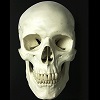4.2: Bones in the Feet
- Page ID
- 11444
The tarsus or posterior portion of the foot is comprised of seven individual bones. A part of the ankle joint is formed by the talus: articulating superiorly and medially with the tibia, laterally with the fibula, inferiorly with the calcaneus, and distally with the navicular bone. The calcaneus or heel is the largest of the tarsal bones, it is located inferiorly and posteriorly in the foot. The other tarsal bones are the cuboid, navicular, and three cuneiform bones. Between the first metatarsal bone and the first cuneiform bone the tarso-metatarsal joint does not allow opposition between the great toe and the remaining digits as in some lower primate forms. In man, the analog in the hand represented by the first carpo-metacarpal joints does permit this unique function.
The middle portion of the foot is made up of the metatarsal bones. The phalanges are the toe bones. Only a proximal and distal phalanx are present in the great toe while the other digits have a middle phalanx as well.
The tarsal bones are much larger than the carpal bones due to their weight bearing requirements. The tarsals and metatarsals form a unit with a limited degree of flexibility. The articulation of the talus and distal epiphysis of the tibia and fibula allow for a strictly hinge-like motion. The most flexible joints within the tarsals are those between the anterior surface of the talus and the navicular, and between the anterior surface of the calcaneus and the cuboid. The motions by which the sole of the foot may be slightly turned medially or laterally, take place at these two joints. Observation of the sole of the articulated foot skeleton will show a considerable concavity between the tuberosity of the calcaneus and the distal ends of the metatarsals. This concavity in life is filled with muscles and any weakening of this arch causes the weight of the body to come to rest on the muscles with painful results. Note the firm articulation between the tarsals and the proximal portions of the metatarsals.
The phalanges of the foot may be readily distinguished from those of the hand by their shortness and roundness of the shaft.
Notes on Sliding*
Calcaneus - Place heel posteriorly, sustentaculum tali (projection) is medial. The projection points toward the opposite side from which the bone comes.
Talus - Place the rounded head anteriorly, the trochlear surface for the tibia is superior, the straightest side is medial, and the angular projecting articulation points laterally. The angular projection points toward the side from which the bone comes.
Navicular - Position the concave surface posteriorly, the convex surface should be anterior with the wide surface superior and the tuberosity medial. The tuberosity points toward the side from which the bone comes.
Cuboid - Hold the large non-articulating surface toward you, the tuberosity points toward the side from which the bone comes.
Cuneiform I - Represents the largest of the cuneiform bones. The large articulating surface is anterior, the sharp ridge superior, and the rough surface without any articulation is medial.
Cuneiform II - Represents the smallest of the cuneiform bones. If the rectangular rough surface without articulations is placed superiorly, the concave triangular facet posteriorly, then the surface with “L” shaped facets is medial.
Cuneiform III - Medium in size compared to the other cuneiform bones. If the rectangular rough surface without articulations is placed superiorly, the triangular articulation posterior (small notch at the apex), then the surface with the two small facets is medial.
*Siding of the hands after White 2000.
Non-Metric Traits of the Feet
Bipartite anterior calcaneal facet - Division of the anterior calcaneal facet. (Mann and Hunt 2005).
Calcaneus secondarius - Accessory bone on the anterior aspect of the anterior calcaneal facet. Notch on the calcaneal facet will be porous, centrally roughened, and concave (Mann and Hunt 2005).
Os trigonum - Accessory bone in the area of the posterior tubercle of the talus (Mann and Hunt 2005).
.png?revision=1)
Calcaneus. Right side. Left superior, Middle inferior, and Right anterior view.
.png?revision=2)
Calcaneus. Right side. Top lateral and Bottom medial.
.png?revision=2)
Talus. Left side. Left superior and Right inferior
.png?revision=1)
Talus. Left side. Left medial and Right lateral
.png?revision=1)
Navicular. Left side. Left articulation with talus, Middle articulation with cuneiforms, and Right non-articular view.
.png?revision=1)
Cubiod. Right side. Left non-articular view, Middle cuboid tuberosity, Right view from the lateral cuneiform.
.png?revision=1)
Cuboid. Right side. Left view from the calcaneus and Right view from the 4th and 5th metatarsal bases.
.png?revision=2)
Cuneiform I. Left side. Left view from navicular, Middle left medial view, Middle right kidney shaped articulation, Right view from 2nd cuneiform.
.png?revision=1)
Cuneiform II. Left side. Left view from navicular, Middle view form 3rd cuneiform, Right view from 1st cuneiform.
.png?revision=1)
Cuneiform III. Left side. Left view from 2nd cuneiform, Middle left Africa shaped articulation, Middle right view from navicular, Right view from cuboid.
.png?revision=1)
Metatarsal 1. Left side. Left medial, Middle left plantar, Middle right lateral, Right dorsal, Bottom proximal base.
.png?revision=1)
Metatarsal 2. Left side. Left medial, Middle left plantar, Middle right lateral, Right proximal base.
.png?revision=1)
Metatarsal 3. Left side. Left medial, Middle left plantar, Middle right lateral, Right proximal base.
.png?revision=1)
Metatarsal 4. Left side. Left medial, Middle left plantar, Middle right lateral, Right proximal base.
.png?revision=1)
Metatarsal 5. Right side. Left medial, Middle left plantar, Middle right lateral, Right proximal base.
.png?revision=2)
Proximal Phalanges of First Toe. Left dorsal Middle plantar, Right distal articulation.
.png?revision=1)
Proximal Phalanges of Non-First Toes. Left dorsal, Middle plantar, Right proximal base.
.png?revision=1)
Medial Phalanges.
.png?revision=1)
Distal Phalanges. Left dorsal, Middle plantar, and Right proximal base.
.png?revision=1)
Foot


